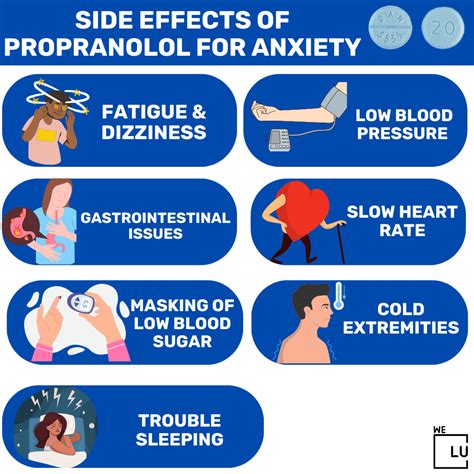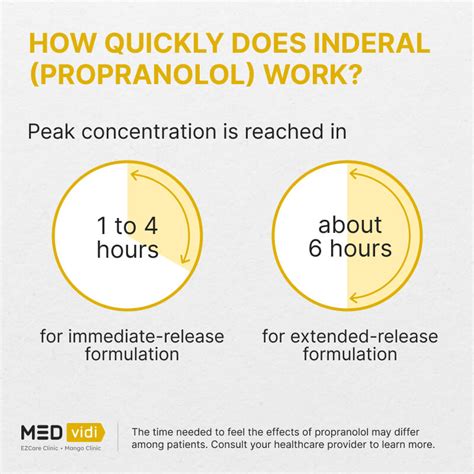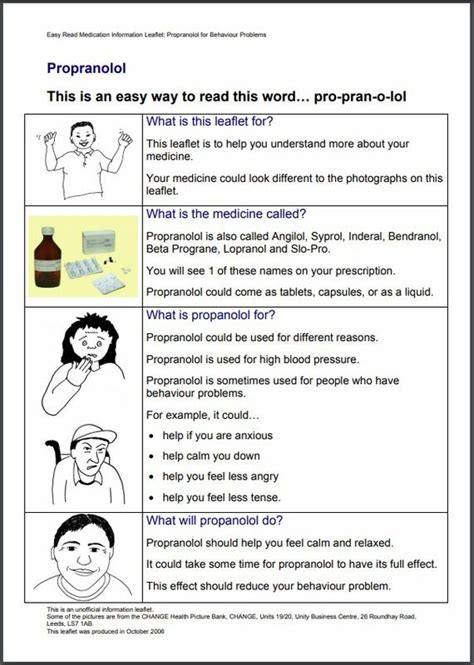Intro
Discover Propanolol side effects, including beta blocker symptoms, anxiety, and blood pressure impacts, to manage risks and interactions with other medications.
Propranolol is a medication that belongs to the class of beta-blockers, which are used to treat various health conditions such as high blood pressure, angina, irregular heartbeats, and certain types of tremors. It works by blocking the action of certain natural chemicals in the body, such as epinephrine, which can increase heart rate and blood pressure. While propranolol is effective in managing these conditions, it can also cause a range of side effects, some of which can be mild and temporary, while others can be more severe and long-lasting.
The importance of understanding the potential side effects of propranolol cannot be overstated, as it can help individuals who are taking this medication to be aware of what to expect and to take steps to manage any adverse effects. Moreover, being informed about the potential side effects of propranolol can also help individuals to make informed decisions about their treatment options and to discuss any concerns they may have with their healthcare provider. In this article, we will delve into the various side effects of propranolol, including common and rare side effects, as well as those that can be serious and potentially life-threatening.
Propranolol is a widely used medication, and its side effects can vary from person to person. While some individuals may experience mild and temporary side effects, others may experience more severe and long-lasting effects. It is essential to note that the severity and frequency of side effects can depend on various factors, such as the dose and duration of treatment, as well as individual characteristics, such as age, sex, and overall health. By understanding the potential side effects of propranolol, individuals can take steps to minimize their risk and to manage any adverse effects that may occur.
Common Side Effects of Propranolol

The common side effects of propranolol can include dizziness, lightheadedness, and fatigue, which can occur due to the medication's effect on blood pressure and heart rate. Other common side effects can include nausea, vomiting, diarrhea, and abdominal pain, which can be mild and temporary. Additionally, propranolol can cause sleep disturbances, such as insomnia and vivid dreams, as well as mood changes, such as depression and anxiety. These side effects can be managed by adjusting the dose or switching to a different medication.
Less Common Side Effects of Propranolol
Propranolol can also cause less common side effects, such as shortness of breath, wheezing, and coughing, which can occur due to the medication's effect on the lungs. Other less common side effects can include swelling of the feet, ankles, and hands, as well as numbness or tingling in the hands and feet. Additionally, propranolol can cause changes in vision, such as blurred vision and double vision, as well as hearing loss and tinnitus. These side effects can be more severe and may require medical attention.Serious Side Effects of Propranolol

Propranolol can also cause serious side effects, such as allergic reactions, which can include symptoms such as hives, itching, and difficulty breathing. Other serious side effects can include abnormal heart rhythms, such as bradycardia and tachycardia, as well as heart failure and cardiac arrest. Additionally, propranolol can cause liver damage and jaundice, as well as kidney damage and kidney failure. These side effects can be life-threatening and require immediate medical attention.
Managing Side Effects of Propranolol
Managing the side effects of propranolol can involve adjusting the dose or switching to a different medication. Additionally, individuals can take steps to minimize their risk of side effects, such as taking the medication as directed, avoiding certain foods and activities, and monitoring their blood pressure and heart rate regularly. It is also essential to discuss any concerns or questions with a healthcare provider, who can provide guidance and support throughout the treatment process.Long-Term Effects of Propranolol

The long-term effects of propranolol can include changes in blood pressure and heart rate, as well as changes in lipid profiles and glucose metabolism. Additionally, propranolol can cause changes in kidney function and liver function, as well as changes in cognitive function and mood. These effects can be beneficial for individuals with certain health conditions, such as high blood pressure and angina, but can also be adverse for individuals with other health conditions, such as asthma and diabetes.
Benefits and Risks of Propranolol
The benefits of propranolol can include improved blood pressure control, reduced risk of heart attack and stroke, and improved symptoms of angina and tremors. However, the risks of propranolol can include serious side effects, such as allergic reactions and heart failure, as well as long-term effects, such as changes in kidney function and liver function. By weighing the benefits and risks of propranolol, individuals can make informed decisions about their treatment options and discuss any concerns they may have with their healthcare provider.Interactions with Other Medications

Propranolol can interact with other medications, such as beta-agonists, which can increase the risk of side effects, such as bronchospasm and hypotension. Additionally, propranolol can interact with other medications, such as warfarin and aspirin, which can increase the risk of bleeding and bruising. It is essential to discuss any medications or supplements with a healthcare provider, who can provide guidance and support throughout the treatment process.
Precautions and Warnings
Propranolol can cause precautions and warnings, such as hypotension and bradycardia, which can occur due to the medication's effect on blood pressure and heart rate. Additionally, propranolol can cause precautions and warnings, such as asthma and COPD, which can occur due to the medication's effect on the lungs. It is essential to discuss any precautions and warnings with a healthcare provider, who can provide guidance and support throughout the treatment process.Patient Education and Support

Patient education and support can play a crucial role in managing the side effects of propranolol. Individuals can learn about the potential side effects of propranolol, as well as how to manage them, by discussing any concerns or questions with a healthcare provider. Additionally, individuals can learn about lifestyle changes, such as diet and exercise, which can help to minimize the risk of side effects and improve overall health.
Conclusion and Future Directions
In conclusion, propranolol is a widely used medication that can cause a range of side effects, some of which can be mild and temporary, while others can be more severe and long-lasting. By understanding the potential side effects of propranolol, individuals can take steps to minimize their risk and to manage any adverse effects that may occur. Future directions for research and development can include the development of new medications and therapies, which can help to improve the management of side effects and improve overall health outcomes.What are the common side effects of propranolol?
+The common side effects of propranolol can include dizziness, lightheadedness, and fatigue, as well as nausea, vomiting, diarrhea, and abdominal pain.
Can propranolol cause serious side effects?
+Yes, propranolol can cause serious side effects, such as allergic reactions, abnormal heart rhythms, and liver damage.
How can I manage the side effects of propranolol?
+You can manage the side effects of propranolol by adjusting the dose or switching to a different medication, as well as taking steps to minimize your risk, such as monitoring your blood pressure and heart rate regularly.
We hope this article has provided you with a comprehensive understanding of the side effects of propranolol. If you have any further questions or concerns, please do not hesitate to comment below or share this article with others. Additionally, if you are taking propranolol or are considering taking it, we encourage you to discuss any concerns or questions with your healthcare provider, who can provide guidance and support throughout the treatment process.
